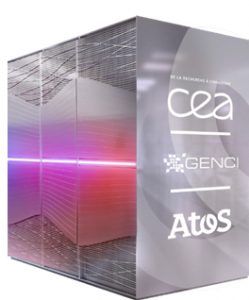Joliot-Curie French HPC Hosted by CEA and Designed by Atos
To reach 20 petaflops in 2020, 5PB of storage
This is a Press Release edited by StorageNewsletter.com on June 11, 2019 at 2:32 pmDesigned by Atos SE, for the French national HPC organisation (GENCI), this supercomputer located at the CEA’s Very Large Computing Centre (TGCC) was inaugurated on 3 June 2019 by François Jacq, CEA chairman, Thierry Breton, Atos CEO, and Philippe Lavocat, GENCI CEO.

Joliot-Curie, GENCI’s new HPC hosted by CEA
Designed by Atos for GENCI, the Joliot-Curie supercomputer is based on Atos’ BullSequana architecture, delivering a peak power of 9.4 petaflops, representing a 4.5 increase in computing capacity compared to its predecessor, Curie, with almost half the power consumption. It will reach 22 petaflops of processing power by 2020.
Joliot-Curie is France’s third HPC ranked in the Top 500 in terms of power, just behind Tera-1000-2 and Pangea1.
Its computing power is equivalent to 75,000 desktop computers and will support researchers for projects requiring heavy computing and data processing. This HPC offers RAM capacity of 400TB. It also includes a 5PB storage capacity with a 300GB/s bandwidth, remote data visualisation and virtualisation services. This makes Joliot-Curie a machine that meets the needs both for large-scale computer simulations and for processing the large amounts of data generated.
Its computing power will be more than doubled in 2020 to reach 22 petaflops or 22 million billion operations per second. It will then become the third most powerful research supercomputer in Europe and no. 1 in France. The HPC will be increasing its power in order to keep up with the international race towards exascale, i.e. a computing power of one billion billion operations per second, which represents a strategic goal for the competitiveness of stakeholders in the digital economy.
Thanks to the investment made by GENCI, a non-commercial company whose shares are held by the French State via the Ministry of Higher Education, Research and Innovation, CEA, CNRS, various universities, and Inria, Joliot-Curie will also ensure that France meets its commitments in terms of computing power made available to European researchers in the context of the PRACE European computing infrastructure2.
Needed tool for scientific and industrial research
HPCs have improved over time and are used in various research fields since they allow for computer simulation3 to be applied across all academic disciplines. Joliot-Curie has already been tested as part of the Grands Challenges (Great challenges), organised by GENCI at the TGCC, by running major simulations and other applications.
Computer simulation and HPC have become essential scientific tools to improve knowledge, design and decision-making processes in fundamental and applied research fields, and an increasing number of industrial sectors.
CEA’s TGCC is a large computing centre based in Bruyères-le-Châtel (Essonne département) and dedicated to HPC in scientific fields.
Alongside Cobalt, a HPC targeting the industrial sector, TGCC hosts the new Joliot-Curie supercomputer, which aims to meet research computing needs. Joliot-Curie is currently used in over a dozen fields such as climate, astrophysics and geophysics, biology, molecular dynamics and material properties, and will also be applied to the genome and neuroscience fields in the near future.
1 Total group supercomputer
2 Partnership for advanced computing in Europe.
3 Calculations performed to represent a complex physical, biological, chemical phenomenon on a computer













 Subscribe to our free daily newsletter
Subscribe to our free daily newsletter

